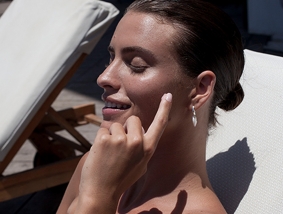In a world with so much pollution, environmental aggressors, junk food, and stressful jobs, your skin’s condition and needs might be changing at the speed of light. And to add to all that, your hormones continue to fluctuate and naturally come into new balances, affecting your skin and making it even harder to determine what it needs.
To have a skin care routine that elevates your skin care regime, whether it’s the Korean skin care routine or the Western 3-step routine, you must first know what your skin type is. The fact is, some of your existing products might be making your skin condition worse. And before you buy new ones, it’s crucial that you know what’s going on with your skin. After all, good skin care is all about customization.

How can I identify my skin type?
Your skin is unique, kind of like your fingerprints. Yet, unlike your fingerprints, your skin has tendencies. For example, a tendency to over or underproduce sebum (oil), or a tendency to get inflamed throughout the day. It’s these tendencies that will help you identify your skin type.
And if you have oily skin, it’s crucial for you to use oil-free, water-based, or oil-absorbing products.
Oily skin checklist
Do you have large, visible pores? Does your skin develop a shiny layer soon after you cleanse, making makeup application challenging? Throughout the day, does your makeup move around on your skin? Do you sometimes experience breakouts of blackheads, pimples, or other blemishes? If you answered yes to at least three out of the four questions we presented, then you’ve got oily skin.
Dry Skin
Do you experience persistent dryness? Does your skin often feel itchy? Does it get red, flaky, or tight? Do you have a dull, rough complexion? Then, yes, you have dry skin and you must use products that deliver extra hydration and moisture. Use hydrating water, facial essence, and a sheet of hydrogel mask to address the problem. Pick a moisturizer that’s specifically formulated for dry skin and has essential oils.
Combination Skin
If you have an oily T-zone and dry skin on the cheeks, you have combination skin.
Oily-Dry Skin
Many people who have oily skin can also experience extreme dryness. This is because oil does not equal moisture. There’s a big difference between the two. While your skin can have sufficient or even an overproduction of oil, it can still be lacking in water. It can look shiny yet feel dry under that sheen. If this is the case, use oil-free, water-based products that offer intense hydration. Never skip cleansing (to get rid of oil) and moisturizing (to offset dryness).
Still not happy? Check the ingredients.
If you’re sure you’re using products that address your particular skin type and concerns yet you still have a negative or even an allergic reaction, make sure to check the ingredients in each product. Use the products separately and see if your skin reacts. If a product feels and looks great on you, note which ingredients might be helping. Over time, paying close attention to different ingredients will help you to identify what your skin likes and dislikes.
You might also like

How to Create a Luxurious Home Spa in 6 Easy Steps
July 9, 2019
The Ultimate Korean Beauty At-Home Indulgences
April 24, 2022




